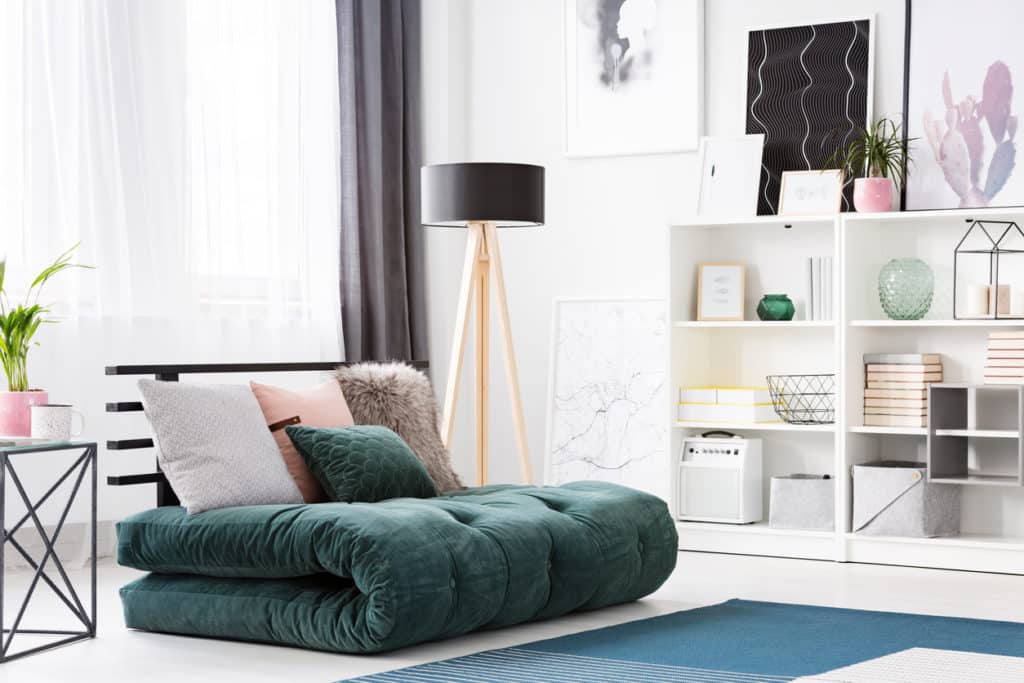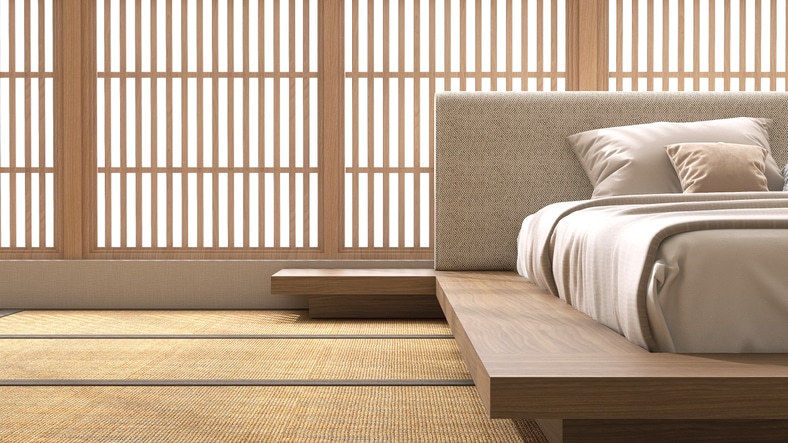Floor sleeping is not something that is very common in the United States but it is in many cultures around the world. Technically, a floor mattress is portable and can be folded or rolled up for easy storage, therefore, it also tends to be thinner and lighter than a conventional mattress. Floor mattresses may be a necessary option for tight spaces, traveling or if you have an on-the-go lifestyle.
Common floor mattresses are often made of polyfoam, memory foam, latex, cotton, polyester or a combination of these materials. They are thin so they are best suited for back and stomach sleepers that prefer a firm surface. If you are a side sleeper, you may want to try a thicker version or a more standard mattress style to relieve stress on your pressure point areas like your hips and shoulders.
Mattresses On The Floor – Why Do People Do This?
A floor mattress for sleeping is believed to be good for your posture and may reduce lower back pain and joint stiffness, but there is no scientific evidence of this.
For stomach and back sleepers, this could be true, but 75% of sleepers tend to be side sleepers which means a mattress on the floor is not ideal for everyone or even most.
There are some advantages to sleeping with your bed on the floor such as being budget friendly since there may be no need for a frame, they are easy to store away, easy to travel with, and great for keeping you cool if you tend to get warm when you sleep. A ground bed gives a minimalist feel and is easy to adapt to any living situation.
How Common Are Floor Beds?
In many cultures it is common to sleep on the floor but since a majority of sleepers prefer to side sleep, it isn’t ideal for everyone.
Many floor mattresses offer minimal pressure relief, which may be comfortable for back and stomach sleepers but may be too firm and unforgiving for side sleepers.
Floor mattresses (and traditional mattresses with thicker foam layers) tend to absorb motion, cradle the curves of your body – especially your hips and shoulders, and redistribute your weight more evenly than a mattress designed for floor sleeping. Side sleepers might find that thin floor mattresses contribute to pressure buildup around the shoulders and hips, and sleepers with mobility issues may also struggle to get in and out of a floor bed.
Is Sleeping On The Floor Good For You?
The cons of floor sleeping include:
- Increased exposure to allergens since the floor quickly collects dust and debris
- It may be hard to get out of bed if you suffer from arthritis or other joint pain
- Too much pressure on your hips and shoulders if you sleep on your side like the majority of sleepers do
- A mattress on the floor may trap moisture that could turn into mold or mildew
Some of the pros of sleeping on the floor are:
- You may sleep cooler since warm air rises
- It might improve your posture and relieve sciatica by keeping your spine in its natural alignment
- It is more economical since you are not spending money on fancy frames and layers of comfort materials
- It’s great for small spaces because floor mattresses are easy to move and store out of the way
Mattress On Floor Ideas
If you need a mattress for occasional use and want to be able to store it away most of the time, then a roll-up floor mattress might work best for you. Foldable floor mattresses are more supportive and are a better choice for nightly sleeping, but are harder to store as they are bulkier.

Children Sleeping On The Floor
Children, especially toddlers, may benefit the most from floor sleeping since a floor bed allows them the independence they need to go to sleep and get up naturally on their own without a parent’s help or the fear of falling out of a standard bed or climbing out of a crib.
Floor Bed Frames And Box Spring Alternatives
Sleeping directly on the bare floor is hard so a barrier between the floor and your mattress is recommended for many reasons. A wooden pallet, a low-profile foundation, a low box spring, a platform base or slatted base will not only allow for better air circulation and temperature control but also to prevent mold and mildew from forming.
An on-the-floor bed frame will protect you and your mattress from insects, dust, dirt and moisture. There are a variety of different floor bed frame options available on the market including a platform base, a slatted base, a floating frame, a regular or low-profile foundation, a trundle bed and a Murphy bed, to name a few.
Best Floor Mattress
There are a few types of floor mattresses on the market, or you can go for a bed-in-the-box style, lightweight memory foam or hybrid mattress. If you are a side sleeper and able to place a standard mattress close to the floor it may be beneficial for your comfort but not ideal for storing or traveling.
Foldable Mattresses
Foldable mattresses usually come in a few variations such as a tri-fold mattress that can be folded and stored or a convertible mattress that can turn into a sofa or chair.
Roll-Up Mattresses
Roll-up mattresses are more compact and more lightweight but are also thinner than foldable ones so they have a firmer feel which is not recommended for side sleepers.
Floor Futon Mattresses
Floor futons are a kind of roll-up mattress, but they have a couple of distinctive features like a washable cover and a fiber core instead of solid foam.
Will A Floor Mattress Work For You?
Before you decide to go with a floor bed, you may want to research your options. Your weight, lifestyle, sleeping position and overall health may help you decide on the best option to choose. A floor mattress is not an ideal choice for everyone.
Other alternatives that may work on a low-profile foundation or platform include our 10″ Songbird in soft or firm or our 10″ Chill Series Euphoria. They are not as lightweight as the foldable or roll-up floor mattresses and definitely can not be rolled up or folded, but will give you enough comfort and support for all sleeping positions.
If you visit a Mattress Express location near you, a sleep specialist can help advise you on what style mattress is going to benefit you most.

